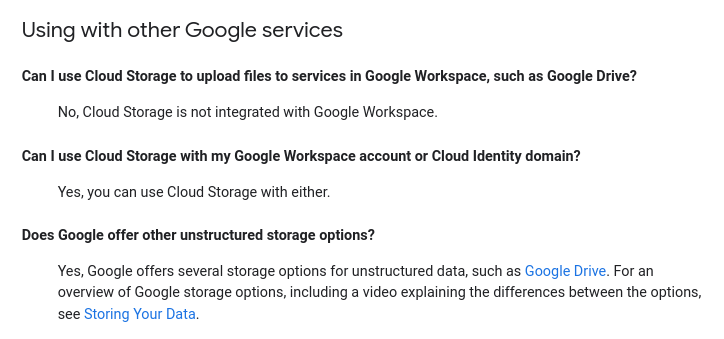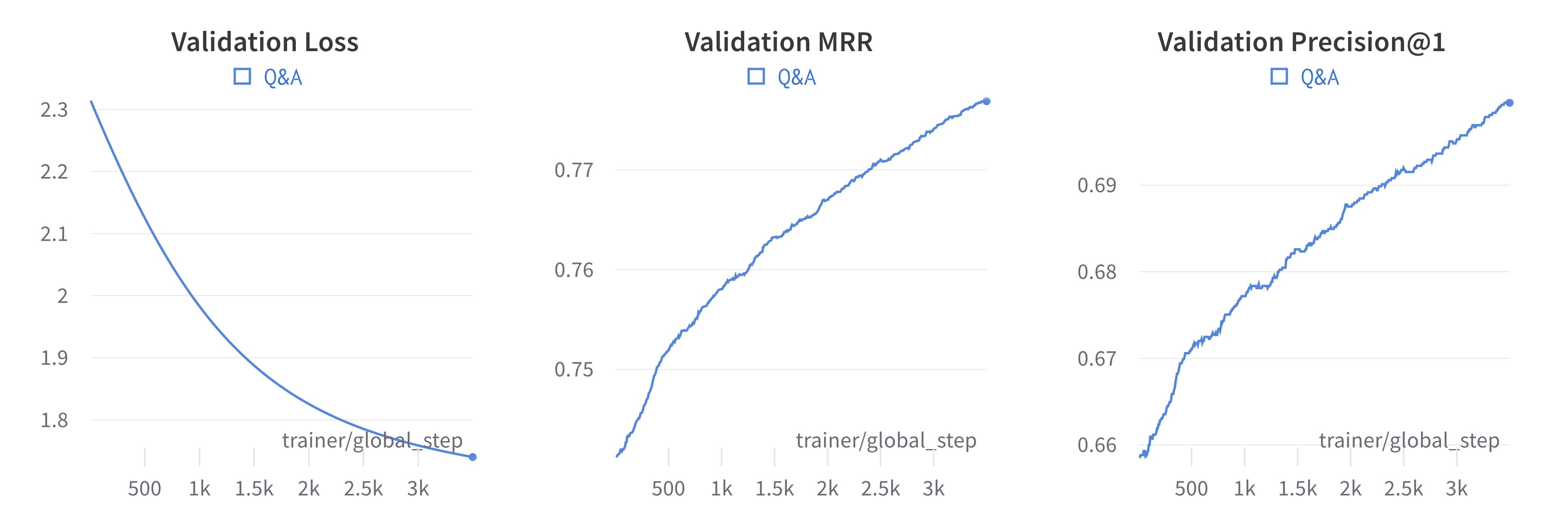Question Answering with similarity learning¶
Intro¶
In this tutorial we will solve a Q&A problem to show how common NLP tasks can be tackled with similarity learning and Quaterion.
We will use cloud-faq-dataset. This is a collection of almost 8.5k pairs of questions and answers from F.A.Q. pages of popular cloud providers.

Example of FAQ section¶
The usual pipeline in Quaterion includes the following steps:
Download and prepare a dataset
Create Encoders
Construct TrainableModel
Train
Evaluate
Let’s stick with it and implement step-by-step.
(For ones who are not interested in the text - here is a repo with the whole tutorial code.)
Download & prepare dataset¶
Data can be downloaded via the following bash command:
$ wget https://storage.googleapis.com/demo-cloud-faq/dataset/cloud_faq_dataset.jsonl -O cloud_faq_dataset.jsonl
Example of pairs presented in dataset:
question: what is the pricing of aws lambda functions powered by aws graviton2 processors?
answer: aws lambda functions powered by aws graviton2 processors are 20% cheaper compared to x86-based lambda functions
Data have to be represented as SimilaritySample instances. With questions and answers we can use SimilarityPairSample.
class SimilarityPairSample:
obj_a: Any # question
obj_b: Any # answer
score: float = 1.0 # Measure of similarity. Usually converted to bool
# Consider all examples outside this group as negative samples.
# By default, all samples belong to group 0 - therefore other samples could not be used as negative examples.
subgroup: int = 0
We will use torch.utils.data.Dataset to convert data and feed it to the model.
Code to split the data is omitted but can be found in the repository.
import json
from typing import List, Dict
from torch.utils.data import Dataset
from quaterion.dataset.similarity_samples import SimilarityPairSample
class FAQDataset(Dataset):
def __init__(self, dataset_path):
self.dataset: List[Dict[str, str]] = self.read_dataset(dataset_path)
def __getitem__(self, index) -> SimilarityPairSample:
line = self.dataset[index]
question = line["question"]
# All questions have a unique subgroup
# Meaning that all other answers are considered negative pairs
subgroup = hash(question)
score = 1
return SimilarityPairSample(
obj_a=question, obj_b=line["answer"], score=score, subgroup=subgroup
)
def __len__(self):
return len(self.dataset)
@staticmethod
def read_dataset(dataset_path) -> List[Dict[str, str]]:
"""Read jsonl-file into a memory."""
with open(dataset_path, "r") as fd:
return [json.loads(json_line) for json_line in fd]
Encoder definition¶
We are going to use pretrained all-MiniLM-L6-v2 from sentence-transformers library as our text encoder.
import os
from torch import Tensor, nn
from sentence_transformers.models import Transformer, Pooling
from quaterion_models.types import TensorInterchange, CollateFnType
from quaterion_models.encoders import Encoder
class FAQEncoder(Encoder):
def __init__(self, transformer, pooling):
super().__init__()
self.transformer = transformer
self.pooling = pooling
self.encoder = nn.Sequential(self.transformer, self.pooling)
@property
def trainable(self) -> bool:
# Defines if we want to train encoder itself, or head layer only
return False
@property
def embedding_size(self) -> int:
return self.transformer.get_word_embedding_dimension()
def forward(self, batch: TensorInterchange) -> Tensor:
return self.encoder(batch)["sentence_embedding"]
def get_collate_fn(self) -> CollateFnType:
# `collate_fn` is a function that converts input samples into Tensor(s) for use as encoder input.
return self.transformer.tokenize
@staticmethod
def _transformer_path(path: str) -> str:
# just an additional method to reduce amount of repeated code
return os.path.join(path, "transformer")
@staticmethod
def _pooling_path(path: str) -> str:
return os.path.join(path, "pooling")
def save(self, output_path: str):
# to provide correct saving of encoder layers we need to implement it manually
transformer_path = self._transformer_path(output_path)
os.makedirs(transformer_path, exist_ok=True)
pooling_path = self._pooling_path(output_path)
os.makedirs(pooling_path, exist_ok=True)
self.transformer.save(transformer_path)
self.pooling.save(pooling_path)
@classmethod
def load(cls, input_path: str) -> Encoder:
transformer = Transformer.load(cls._transformer_path(input_path))
pooling = Pooling.load(cls._pooling_path(input_path))
return cls(transformer=transformer, pooling=pooling)
We return False in trainable - it means that our encoder is frozen and the encoder’s weights won’t change during training.
Trainable model constructing¶
One of the main entities in Quaterion is TrainableModel.
It handles the majority of the training routine and constructs the final model from blocks.
Here we need to configure encoders, heads, loss, optimizer, metrics, cache, etc.
TrainableModel is actually pytorch_lightning.LightningModule, hence obtains all LightningModule features.
from quaterion.eval.attached_metric import AttachedMetric
from torch.optim import Adam
from quaterion import TrainableModel
from quaterion.train.cache import CacheConfig, CacheType
from quaterion.loss import MultipleNegativesRankingLoss
from sentence_transformers import SentenceTransformer
from quaterion.eval.pair import RetrievalPrecision, RetrievalReciprocalRank
from sentence_transformers.models import Transformer, Pooling
from quaterion_models.heads.skip_connection_head import SkipConnectionHead
class FAQModel(TrainableModel):
def __init__(self, lr=10e-5, *args, **kwargs):
self.lr = lr
super().__init__(*args, **kwargs)
def configure_metrics(self):
# attach batch-wise metrics which will be automatically computed and logged during training
return [
AttachedMetric(
"RetrievalPrecision",
RetrievalPrecision(k=1),
prog_bar=True,
on_epoch=True,
),
AttachedMetric(
"RetrievalReciprocalRank",
RetrievalReciprocalRank(),
prog_bar=True,
on_epoch=True
),
]
def configure_optimizers(self):
return Adam(self.model.parameters(), lr=self.lr)
def configure_loss(self):
# `symmetric` means that we take into account correctness of both the closest answer to a question and the closest question to an answer
return MultipleNegativesRankingLoss(symmetric=True)
def configure_encoders(self):
pre_trained_model = SentenceTransformer("all-MiniLM-L6-v2")
transformer: Transformer = pre_trained_model[0]
pooling: Pooling = pre_trained_model[1]
encoder = FAQEncoder(transformer, pooling)
return encoder
def configure_head(self, input_embedding_size: int):
return SkipConnectionHead(input_embedding_size)
def configure_caches(self):
# Cache stores frozen encoder embeddings to prevent repeated calculations and increase training speed.
# AUTO preserves the current encoder's device as storage, batch size does not affect training and is used only to fill the cache before training.
return CacheConfig(CacheType.AUTO, batch_size=256)
Train & Evaluate¶
We will merge the last 2 steps and perform training and evaluation in one function. For the training process we need to create pytorch_lightning.Trainer instance to handle training routine, also datasets and data loaders instances to prepare our data and feed it to the model. Finally, to launch the training process all of these should be passed to Quaterion.fit. Batch-wise evaluation will be performed during training, but it can fluctuate a lot depending on a batch size. More representative results from larger part of the data can be obtained via Evaluator and Quaterion.evaluate.
At the end trained model is saved under servable dir.
import os
import torch
import pytorch_lightning as pl
from quaterion import Quaterion
from quaterion.dataset import PairsSimilarityDataLoader
from quaterion.eval.evaluator import Evaluator
from quaterion.eval.pair import RetrievalReciprocalRank, RetrievalPrecision
from quaterion.eval.samplers.pair_sampler import PairSampler
DATA_DIR = 'data'
def run(model, train_dataset_path, val_dataset_path, params):
use_gpu = params.get("cuda", torch.cuda.is_available())
trainer = pl.Trainer(
min_epochs=params.get("min_epochs", 1),
max_epochs=params.get("max_epochs", 300), # cache makes it possible to use a huge amount of epochs
auto_select_gpus=use_gpu,
log_every_n_steps=params.get("log_every_n_steps", 10), # increase to speed up training
gpus=int(use_gpu),
num_sanity_val_steps=2,
)
train_dataset = FAQDataset(train_dataset_path)
val_dataset = FAQDataset(val_dataset_path)
train_dataloader = PairsSimilarityDataLoader(train_dataset, batch_size=1024)
val_dataloader = PairsSimilarityDataLoader(val_dataset, batch_size=1024)
Quaterion.fit(model, trainer, train_dataloader, val_dataloader)
metrics = {
"rrk": RetrievalReciprocalRank(),
"rp@1": RetrievalPrecision(k=1)
}
sampler = PairSampler()
evaluator = Evaluator(metrics, sampler)
results = Quaterion.evaluate(evaluator, val_dataset, model.model) # calculate metrics on the whole dataset to obtain more representative metrics values
print(f"results: {results}")
# launch training
pl.seed_everything(42, workers=True)
faq_model = FAQModel()
train_path = os.path.join(DATA_DIR, "train_cloud_faq_dataset.jsonl")
val_path = os.path.join(DATA_DIR, "val_cloud_faq_dataset.jsonl")
run(faq_model, train_path, val_path, {})
faq_model.save_servable("servable")
Here are some of the plots observed during training. As you can see, the loss decreased, while the metrics grew steadily.

Learning curves¶
Additionally, let’s take a look at our model’s performance:
Q: what is the pricing of aws lambda functions powered by aws graviton2 processors?
A: aws lambda functions powered by aws graviton2 processors are 20% cheaper compared to x86-based lambda functions
Q: can i run a cluster or job for a long time?
A: yes, you can run a cluster for as long as is required
Q: what is the dell open manage system administrator suite (omsa)?
A: omsa enables you to perform certain hardware configuration tasks and to monitor the hardware directly via the operating system
Q: what are the differences between the event streams standard and event streams enterprise plans?
A: to find out more information about the different event streams plans, see choosing your plan
That’s it! We’ve just trained similarity learning model to solve Question Answering problem!
Further learning¶
In the case you followed the tutorial step-by-step you might be surprised by the speed of the training process with Quaterion. This is mainly the merit of the cache and frozen encoder. Check out our cache tutorial.

